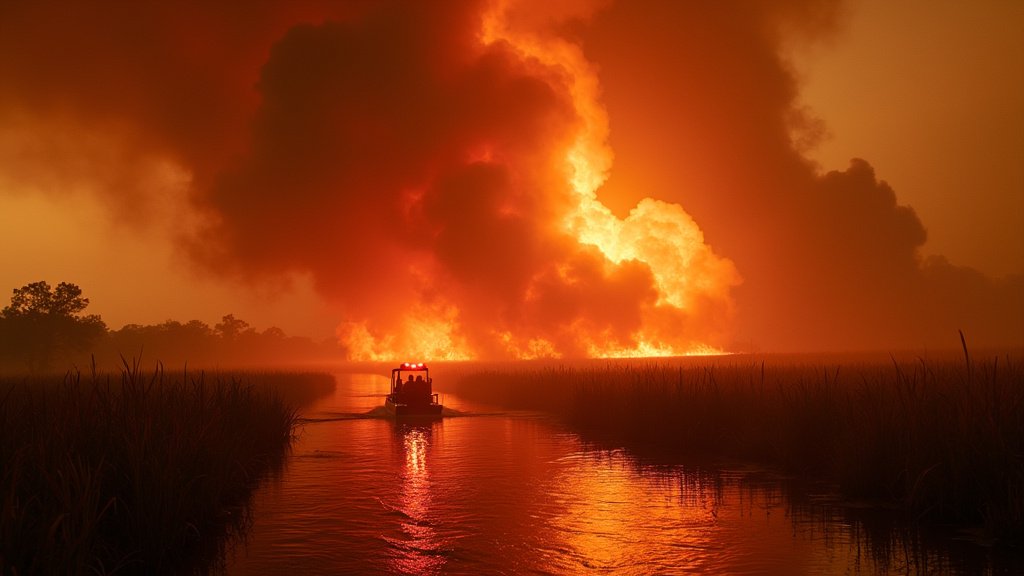The “Mile Marker 39” wildfire, a significant blaze consuming the Florida Everglades, has expanded to approximately 48,000 acres and is now reported to be 60% contained as of Saturday, August 23, 2025. This wildfire, which began on August 18, has become the largest of the year in Florida, drawing considerable attention due to its size and the resulting smoke impacts across South Florida, including the Miami metropolitan area.
Origin and Rapid Growth
The “Mile Marker 39” fire, officially designated with a code of (06), was first reported on Tuesday, August 19, 2025, near Alligator Alley at mile marker 39 in the heart of the Everglades in Broward County. The precise ignition time is still under investigation, but it is believed to have started around 6 p.m. on August 19, shortly after severe thunderstorms with significant lightning passed through the region. Initially, the fire was estimated to cover between 1,600 to 2,000 acres. However, it rapidly merged with a second, smaller blaze known as the Sawgrass Fire, which had burned about 250 acres. This combination led to an explosive growth, with the combined fires escalating to over 42,000 acres by August 22, and reaching 48,000 acres by August 23. The primary fuel for the fire has been identified as sawgrass, a resilient and flammable vegetation native to the Everglades.
Historical Context and Contributing Factors
Wildfires are a natural and historically significant component of the Everglades ecosystem, playing a crucial role in maintaining its biodiversity. Lightning has long been recognized as a primary natural ignition source, accounting for over 50% of wildfires in the region according to some reports. However, environmental conditions in 2025 have exacerbated fire behavior. Persistent rainfall deficits since the start of summer have left both live and dead fuel moisture at critically low levels, accelerating flammability. Experts suggest that the distant track of Hurricane Erin may have also contributed by pulling dry air into the region, further intensifying drought conditions. This has created a highly fire-prone landscape, making the sawgrass particularly susceptible to rapid spread.
Containment Efforts and Challenges
The Florida Forest Service has been leading the suppression efforts, employing a multi-agency approach that includes ground crews, airboats, and aviation resources. Helicopters have been actively making water drops on hot spots. However, firefighters are facing considerable challenges due to the unique and often inaccessible terrain of the Everglades wetlands, which hinders the deployment of heavy equipment and ground access to certain areas. Despite these difficulties, containment has progressed from 0% in the initial days to 60% by August 23, indicating significant progress by the dedicated crews.
Impact on Air Quality and Visibility
The “Mile Marker 39” wildfire has had a substantial impact on air quality across South Florida, particularly in Broward and Miami-Dade counties. Dense smoke plumes have been observed drifting into populated areas, causing hazy skies, reduced visibility on major roadways like I-75 and the Sawgrass Expressway, and a distinct smell of burning vegetation. Air quality indices (AQI) in areas like Broward County and North Miami have reached levels considered “unhealthy” for sensitive groups, prompting health advisories. The National Weather Service issued air quality alerts, urging individuals with respiratory conditions, children, and the elderly to limit their outdoor activities and remain indoors, utilizing air conditioning on recirculate mode.
Ecological Role of Fire and Future Concerns
While the current wildfire poses immediate air quality concerns, it’s important to note the ecological role of fire in the Everglades. Historically, controlled burns have been used to manage the ecosystem, clearing out sawgrass to improve water flow, control invasive species, and promote new growth. The current blaze, though large, burns primarily sawgrass fuels and has not posed a direct threat to structures or resulted in any reported injuries. However, the increased frequency and intensity of wildfires, potentially linked to changing climate patterns leading to hotter and drier conditions, are a growing concern for the long-term health and management of the Everglades.
As of the latest reports on August 23, 2025, the “Mile Marker 39” fire continues to be a trending news topic, with ongoing efforts focused on achieving full containment and monitoring the environmental impacts. The situation highlights the delicate balance between natural fire cycles and the increasing challenges posed by environmental conditions in South Florida’s unique wetland ecosystem.





